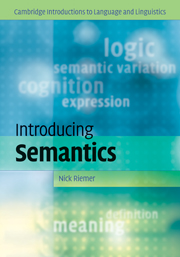Book contents
- Frontmatter
- Contents
- Note to the reader
- 1 Meaning in the empirical study of language
- 2 Meaning and definition
- 3 The scope of meaning I: external context
- 4 The scope of meaning II: interpersonal context
- 5 Analysing and distinguishing meanings
- 6 Logic as a representation of meaning
- 7 Meaning and cognition I: categorization and cognitive semantics
- 8 Meaning and cognition II: formalizing and simulating conceptual representations
- 9 Meaning and morphosyntax I: the semantics of grammatical categories
- 10 Meaning and morphosyntax II: verb meaning and argument structure
- 11 Semantic variation and change
- Glossary
- References
- Index
2 - Meaning and definition
Published online by Cambridge University Press: 05 June 2012
- Frontmatter
- Contents
- Note to the reader
- 1 Meaning in the empirical study of language
- 2 Meaning and definition
- 3 The scope of meaning I: external context
- 4 The scope of meaning II: interpersonal context
- 5 Analysing and distinguishing meanings
- 6 Logic as a representation of meaning
- 7 Meaning and cognition I: categorization and cognitive semantics
- 8 Meaning and cognition II: formalizing and simulating conceptual representations
- 9 Meaning and morphosyntax I: the semantics of grammatical categories
- 10 Meaning and morphosyntax II: verb meaning and argument structure
- 11 Semantic variation and change
- Glossary
- References
- Index
Summary
CHAPTER PREVIEW
This chapter considers the role of definition in the description of meaning, through four main questions:
What units need to receive definition?
What forms should the definitions take?
Can definitions be grounded in a set of semantic primitives?
What is the place of definition in semantics generally?
We begin by contrasting the types of definition that might appear in dictionaries from the types that interest a theoretical semantic analysis (2.1). Before any definition can begin, we have to confront an initial question: what are the meaning-bearing units of the language for which definitions are required? We explore this question by looking at meaning on, above and below the word level in 2.2, paying particular attention to certain problematic cases. The next section distinguishes definition of things (real definition) from definition of meanings (nominal definition), and cognitive from extensional definitions, and discusses some differences of opinion in linguistics as to what the proper objects of linguistic definition are (2.3.1). We then distinguish different possible definitional strategies, including
definition by ostension (2.3.2)
definition by synonymy (2.3.3)
definition by context and typical exemplar (2.3.4)
definition by genus and differentia (2.3.5).
The test of truth preserving substitutability is introduced as a standard criterion of definitional adequacy (2.4), and we discuss the problem of definitional circularity and the question of semantic primitives (2.5).
We then exemplify the extreme difficulty involved in couching successful definitions of words (2.6), before finally devoting some discussion to the relationship between definition and understanding (2.7).
- Type
- Chapter
- Information
- Introducing Semantics , pp. 45 - 86Publisher: Cambridge University PressPrint publication year: 2010



